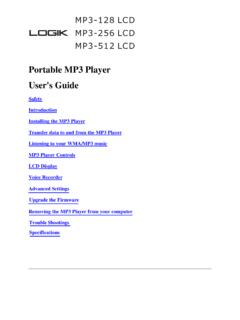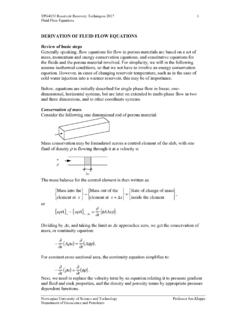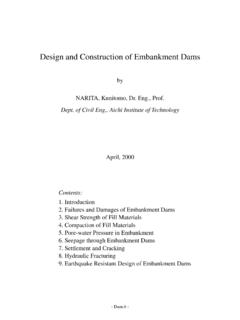Transcription of EXPERIMENTAL RESERVOIR ENGINEERING LABORATORY …
1 IEXPERIMENTAL RESERVOIR ENGINEERINGEXPERIMENTAL RESERVOIR ENGINEERINGEXPERIMENTAL RESERVOIR ENGINEERINGEXPERIMENTAL RESERVOIR ENGINEERINGLABORATORY WORK BOOKLABORATORY WORK BOOKLABORATORY WORK BOOKLABORATORY WORK BOOKO. Tors terM. AbtahiDepartment of Petroleum engineeringand Applied GeophysicsNorwegian University of Science and TechnologyAugust, 2000iiPREFACEThis book is intended primarily as a text in the course SIG4015 RESERVOIR PropertyDetermination by Core Analysis and Well Testing at the Norwegian University ofScience and Technology. Part of this course introduces the basic LABORATORY equipmentand procedures used in core analysis and the theoretical aspects of the parameters.
2 Thebook also includes detailed description of LABORATORY exercises suitable for student twelve of the book concludes a Problem Based Learning (PBL) project for is expressed to the students Medad Tweheyo Twimukye and HoangMinh Hai for their contributions to this Tors terManoochehr and saturation injection of solvent distillation determination, Dean-Stark distillation method ( ) of density using the pycnometer ( ) of pressure and temperature on for measuring type ball viscosity measurement using capillary typeviscometer (Exp. 3) of compaction on measurements on core volume volume volume porosity determination by helium porosimetermethod (Exp. 4) determination by liquid saturation method (Exp.)
3 5) of conductive of overburden pressure on of partially water-saturated measurements of fluid-saturated rocks (Exp. 6) and interfacial of interfacial tension rise plate weight drop drop tension (IFT) measurement,pendant drop method (Exp. 7) of IFT with the ring tensiometer (Exp. 8) angle and of on core Amott centrifuge angle contact angle/imaging angle measurement using imaging method (Exp. 9) pressure measurement plate method (restored state) injection (Purcell method) of LABORATORY pressure measurement using porous plate (Exp. 10) pressure measurement using centrifuge (Exp. 11) s gas velocity of head of air permeability (Exp. 12) permeability measurement of water (Exp.
4 13) Flow of immiscible fluids in porous Buckley-Leverett s extended permeability measurement state state relative permeability measurement,unsteady state method (Exp. 14) relative permeability measuring,unsteady state method (Exp. 15)89 References9211. INTRODUCTIONK nowledge of petrophysical and hydrodynamic properties of RESERVOIR rocks are offundamental importance to the petroleum engineer. These data are obtained from twomajor sources: core analysis and well logging. In this book we present some details aboutthe analysis of cores and review the nature and quality of the information that can bededuced from are obtained during the drilling of a well by replacing the drill bit with a diamondcore bit and a core barrel.
5 The core barrel is basically a hollow pipe receiving thecontinuous rock cylinder, and the rock is inside the core barrel when brought to mechanical coring is a costly procedure due to:- The drill string must be pulled out of the hole to replace the normal bit by core bitand core The coring operation itself is The recovery of rocks drilled is not A single core is usually not more than 9 m long, so extra trips out of hole should therefore be detailed programmed, specially in production wells. In anexploration well the coring can not always be accurately planned due to lack ofknowledge about the rock. Now and then there is a need for sample in an already drilledinterval, and then sidewall coring can be applied.
6 In sidewall coring a wireline-conveyedcore gun is used, where a hollow cylindrical bullet is fired in to the wall of the plugs are small and usually not very valuable for RESERVOIR drilling, the core becomes contaminated with drilling mud filtrate and thereduction of pressure and temperature while bringing the core to surface results in gasdissolution and further expansion of fluids. The fluid content of the core observed on thesurface can not be used as a quantitative measure of saturation of oil, gas and water in thereservoir. However, if water based mud is used the presence of oil in the core indicatesthat the rock information is oil the core arrives in the LABORATORY plugs are usually drilled 20-30 cm apartthroughout the RESERVOIR interval.
7 All these plugs are analyzed with respect to porosity,permeability, saturation and lithology. This analysis is usually called routine coreanalysis. The results from routine core analysis are used in interpretation and evaluationof the RESERVOIR . Examples are prediction of gas, oil and water production, definition offluid contacts and volume in place, definition of completion intervals etc. Data fromroutine core analysis and from supplementary tests and the application of these data areasummarized in Table : Routine core analysis and supplementary core analysisPorosityStorage capacityPermeabilityFlow capacitySaturationsDefine the mobile hydrocarbons (productive zones andcontacts), type of hydrocarbonsLithologyRock type and characteristics (fractures, layering etc.)
8 Supplementary measurementVertical permeabilityEffect of coning, gravity drainage surface logIdentify lost core sections, correlate cores and logsMatrix densityCalibrate the density logOil and water analysisDensities, viscosities, interfacial tension, composition core analysis includes several measurements with the objective of obtainingdetailed information about multiphase flow behavior. Special core analysis givesinformation about the distribution of oil, gas, and water in the RESERVOIR (capillarypressure data), residual oil saturation and multiphase flow characteristics (relativepermeabilities). Measurements of electrical and acoustic properties are occasionallyincluded in special core analysis.
9 This information is mainly used in the interpretation ofwell effect of pressure and temperature on rock and fluid properties is in some reservoirformations significant, and LABORATORY measurements should therefore be made at, orcorrected to, RESERVOIR conditions wherever possible. Included in special core analysis isin some cases detailed petrographical analysis of rocks (grain size distribution, clayidentification, diagenesis etc.). Wettability analysis and special tests for enhanced oilrecovery (EOR) are also often part of special core analysis. Table is a list of thevarious special core analysis : Special core testsCompressibility studiesPermeability and porosity vs.
10 PressurePetrographical studiesMineral identification, diagenesis, clay identification,grain size distribution, pore geometry angle and wettability indexCapillarityCapillary pressure vs. saturationAcoustic testsElectric testsDynamic testsFlow studiesRelative permeability and end point saturationsEOR-Flow testsInjectivity and residual AND SATURATION measuring porosity and permeability, the core samples must be cleaned of residualfluids and thoroughly dried. The cleaning process may also be apart of fluid saturation is defined as the ratio of the volume of fluid in a given core sample to thepore volume of the sample() S S gopgpopwwVVVVVVS===() 1 SSgo=++wSwhere Vw, Vo, Vg and Vp are water, oil, gas and pore volumes respectively and Sw, So andSg are water, oil and gas saturations.





